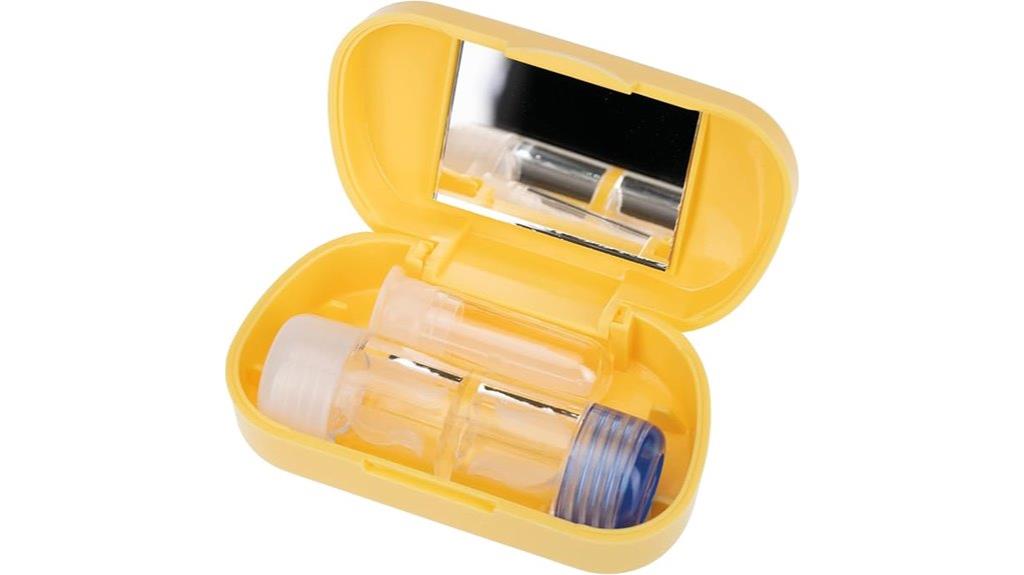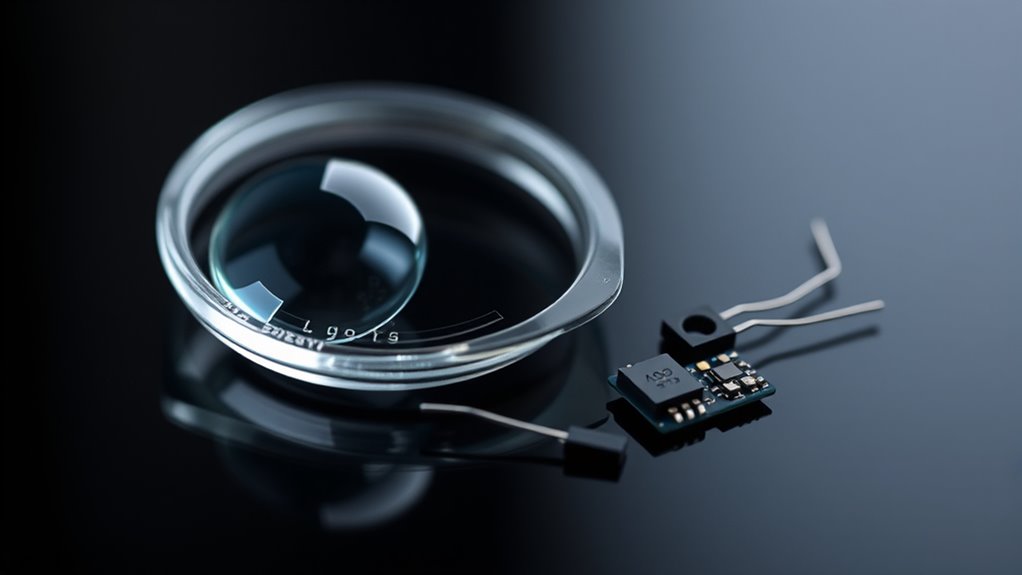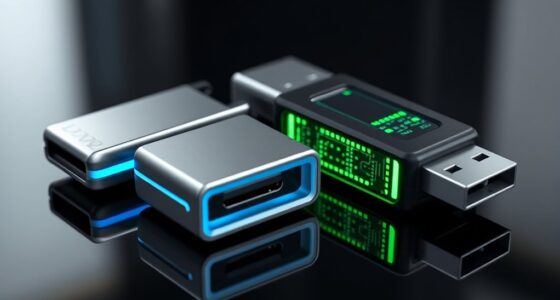In 2025, the top smart contact lens dev kit combines exceptional vision correction, secure wireless connectivity like Bluetooth LE and Wi-Fi, and all-day comfort with biocompatible, flexible materials. It offers long-lasting batteries, advanced electronics, and compliance with safety standards, ensuring reliable performance and durability. If you want to discover more about this innovative kit and how it transforms wearable eye tech, there’s plenty more to explore ahead.
Key Takeaways
- Features advanced integration of vision correction, biometric sensors, and augmented reality, tailored for personalized and evolving user needs.
- Offers extended battery life with energy-efficient components and secure wireless data connectivity options like BLE and Wi-Fi.
- Designed for optimal comfort with biocompatible, flexible materials and ergonomic fitting, ensuring all-day wearability.
- Built using durable, environmentally resistant materials and protective coatings for long-term reliability and safety.
- Complies with international safety standards (ISO 10993, IEC 60601) and regulatory approvals (FDA, MDR) for medical device certification.
Sports Vision World Travel Kit with RGP Hard Contact Lenses Case & Remover

If you’re a hard contact lens wearer who loves to travel or enjoys outdoor activities, the Sports Vision World Travel Kit is an ideal choice. It’s compact, measuring just about 3 inches, and includes a sturdy, leakproof case, a handy mirror, and a suction remover for easy lens handling. Made from durable, odorless materials, it keeps your RGP lenses safe, clean, and protected in any environment. The kit simplifies lens care on the go, reducing germs and bacteria risks. Its small size fits easily into purses or pockets, making it perfect for outdoor adventures, trips, or emergencies. It’s a practical, all-in-one solution for maintaining your lenses while traveling.
Best For: hard contact lens wearers who travel frequently or enjoy outdoor activities and need a compact, reliable storage and care solution for their lenses.
Pros:
- Compact and lightweight design for easy portability
- Durable, leakproof case made from odorless, heavy-metal-free materials
- Includes a mirror and suction remover for convenient lens handling and application
Cons:
- Not suitable for soft contact lenses or other lens types
- Some users report compatibility issues with certain lens sizes or shapes
- Limited capacity, only designed for RGP hard lenses, which may not suit all users
Factors to Consider When Choosing Smart Contact Lens Prototypes (Dev Kits)

When selecting a smart contact lens prototype, I focus on several key factors to guarantee it meets my needs. Compatibility with my vision requirements, battery life, and data connectivity are vital for seamless performance. Comfort, durability, and fit also play a big role in choosing the right dev kit for long-term use.
Compatibility With Vision Needs
Choosing a smart contact lens prototype that truly meets your vision needs requires careful consideration of compatibility factors. First, verify the device supports your specific correction needs, whether it’s myopia, hyperopia, astigmatism, or presbyopia. It’s also important that the dev kit can integrate with your existing prescription and accommodate personalized optical adjustments. Check whether the design allows for updates to adapt to changes in your vision over time. Comfort matters too—verify that the materials and electronics are suitable for sensitive eyes and won’t cause irritation or adverse reactions. Ultimately, consider how well the lens fits your lifestyle—does it support features like blinking, eye movement tracking, or augmented reality integration? Compatibility with your unique vision and daily routines is essential for a successful smart contact lens experience.
Battery Life and Power
Battery life and power management are critical factors in selecting a smart contact lens prototype, as they directly impact usability and convenience. Extended battery life ensures the device can function all day without frequent recharges, which is essential for seamless use. To achieve this, energy-efficient components and thoughtful design help minimize power consumption, keeping the device portable and practical. Rechargeable batteries promote sustainability and reduce the need for replacements, making long-term use more feasible. Environmental factors like temperature and humidity can influence battery performance, so testing under various conditions is necessary. Effective power management systems are crucial to optimize battery use, prevent overheating, and ensure safety during prolonged wear. Ultimately, a well-balanced power solution enhances user experience and device reliability.
Data Connectivity Options
Selecting the right data connectivity options for a smart contact lens prototype is a key step in ensuring reliable performance without draining the device’s limited power resources. Wireless methods like Bluetooth, NFC, and Wi-Fi enable real-time data transfer, essential for health monitoring or augmented reality features. Among these, Bluetooth Low Energy (BLE) is often preferred due to its low power consumption, helping extend battery life. Secure data transmission is critical, so encryption standards like WPA2 or TLS are necessary to protect sensitive health information. Connectivity modules must fit within the tiny form factor of contact lenses, often requiring integrated antennas or ultra-compact components. Additionally, the chosen connection’s latency and bandwidth directly affect how responsive and accurate the device can be, impacting user experience and functionality.
Comfort and Fit Quality
Ensuring comfort and a proper fit for smart contact lens prototypes hinges on accurately matching the lens’s curvature and overall dimensions to the wearer’s eye shape. I focus on selecting materials that are biocompatible and flexible to minimize irritation and guarantee a snug, secure fit during extended wear. Proper edge design and even thickness distribution are essential to reduce dryness, discomfort, and irritation, especially during blinking. Fit testing involves checking how well the lens stays centered and whether it causes pressure points or discomfort. User feedback plays a vital role, guiding iterative adjustments to improve comfort. Since electronic components can affect flexibility, balancing functionality with comfort is crucial. Ultimately, a well-fitted lens enhances user experience and encourages consistent wear.
Durability and Longevity
When designing smart contact lens prototypes, durability and longevity are top priorities to guarantee reliable performance over time. Using durable materials like silicon or hydrogel ensures the lenses can withstand daily wear and environmental factors. The longevity of a prototype also depends on the robustness of its electronic components and protective coatings that guard against scratches, tears, and damage. Resistance to environmental stressors directly impacts the device’s lifespan. Reliable power sources, such as miniaturized batteries or energy-harvesting tech, play an essential role in maintaining durability and extending operational life. To confirm long-term use, thorough testing focuses on material stability and electronic integrity over extended periods. Prioritizing these factors helps develop resilient smart contact lenses that perform consistently over time.
Regulatory and Safety Standards
Regulatory and safety standards play a critical role in shaping the development of smart contact lens prototypes, as they guarantee that these devices are safe and effective for users. Compliance with standards like ISO 10993 for biocompatibility and IEC 60601 for electrical safety is essential. Before bringing a product to market, it must receive approval from agencies like the FDA or European MDR, which requires extensive testing for hazards such as toxicity, heat generation, and electrical malfunctions. Manufacturers also need to provide detailed documentation on manufacturing processes, quality control, and risk management. Additionally, data privacy and security regulations are crucial when smart lenses handle sensitive health information. Meeting these standards ensures user safety, builds trust, and facilitates market approval.
Frequently Asked Questions
How Long Do Smart Contact Lenses Typically Last Before Needing Replacement?
You’re probably wondering how long smart contact lenses last before needing a replacement. Typically, they’re designed to be used daily or over a specific period, often lasting from one day to a month, depending on the model and features. I recommend checking the manufacturer’s guidelines for exact lifespan. Keep in mind, regular replacement guarantees peak performance and eye health. It’s always best to follow recommended usage to avoid complications.
Are There Any Health Risks Associated With Using Smart Contact Lens Prototypes?
Did you know that about 15% of contact lens users experience discomfort or irritation? When it comes to smart contact lenses, there are some health risks to take into account. I’ve read that potential issues include eye infections, allergic reactions, or dryness. It’s vital to follow proper hygiene and consult an eye care professional before using prototypes, as these lenses are still in development and safety isn’t fully guaranteed yet.
Can Smart Contact Lenses Be Customized for Individual Eyesight Needs?
I believe smart contact lenses can definitely be customized for individual eyesight needs. Manufacturers are working on adjustable lenses that can fine-tune focus, much like traditional glasses or contact lenses. This customization guarantees better vision correction and comfort tailored specifically to each person. As technology advances, I’m confident we’ll see more personalized options, making these smart lenses a practical and innovative solution for eye health and vision enhancement.
What Is the Average Cost of a Smart Contact Lens Prototype Dev Kit?
Imagine stepping into the future of tech—costs for smart contact lens prototype dev kits vary. On average, these kits can range from $5,000 to $20,000, depending on features and complexity. Smaller startups might find cheaper options, but high-end kits with advanced sensors and customizations tend to be pricier. I recommend researching specific kits to find one that fits your budget and project needs.
How Do Smart Lenses Connect Securely to Smartphones or Other Devices?
You’re wondering how smart lenses connect securely to smartphones or other devices. I find that most smart lenses use Bluetooth or near-field communication (NFC) for wireless pairing. They often incorporate encryption protocols like WPA2 or SSL to protect data during transmission. I always recommend ensuring your device’s firmware is up to date and using secure pairing methods to prevent unauthorized access. Security is vital for protecting sensitive health and personal data.
Conclusion
Choosing the right smart contact lens prototype is like finding the perfect key to open a new world of vision. With the right dev kit, you’re not just improving sight—you’re stepping into a future where tech and comfort blend seamlessly. So, weigh your needs carefully, and embrace the journey ahead. The lens of tomorrow is waiting, ready to turn your everyday view into an extraordinary adventure.










